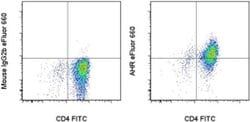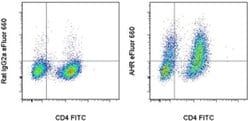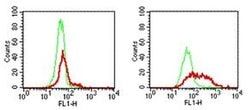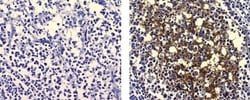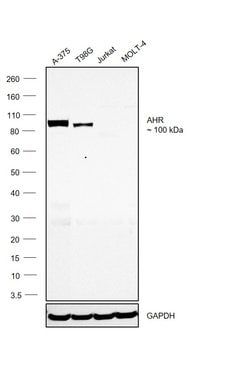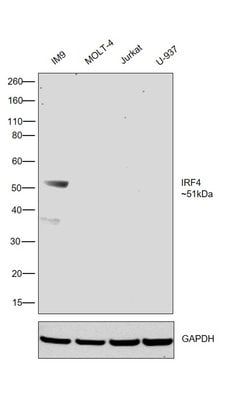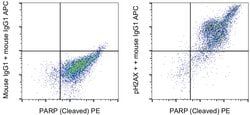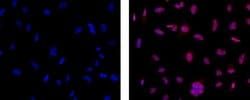14-985-437
AHR Monoclonal Antibody (FF3399), eBioscience™, Invitrogen™
Manufacturer: Invitrogen
Select a Size
| Pack Size | SKU | Availability | Price |
|---|---|---|---|
| Each of 1 | 14-985-437-Each-of-1 | In Stock | ₹ 1,22,108.00 |
14-985-437 - Each of 1
In Stock
Quantity
1
Base Price: ₹ 1,22,108.00
GST (18%): ₹ 21,979.44
Total Price: ₹ 1,44,087.44
Antigen
AHR
Classification
Monoclonal
Concentration
0.5 mg/mL
Formulation
PBS with 0.09% sodium azide; pH 7.2
Gene Accession No.
P35869
Gene Symbols
AHR
Immunogen
21H2-AHR (aa 449-848)
Quantity
2 mg
Primary or Secondary
Primary
Target Species
Human
Product Type
Antibody
Isotype
IgG2b κ
Applications
Flow Cytometry, Immunocytochemistry, Immunohistochemistry (Paraffin), Western Blot
Clone
FF3399
Conjugate
Unconjugated
Gene
AHR
Gene Alias
Ah; Ah receptor; Ahh; Ahr; Ahre; AH-receptor; aromatic hydrocarbon receptor; aryl hydrocarbon receptor; aryl-hydrocarbon receptor; bHLHe76; Class E basic helix-loop-helix protein 76; dioxin receptor; In
Host Species
Mouse
Purification Method
Affinity chromatography
Regulatory Status
RUO
Gene ID (Entrez)
196
Content And Storage
4° C
Form
Liquid
Description
- The FF3399 MAb recognizes human aryl hydrocarbon receptor (AHR)
- The AHR is a ligand-activated transcription factor that mediates the toxic effects of a diverse group of environmental contaminants, most notably aryl hydrocarbons such as polychlorinated biphenyls (PCB) and tetrachlorodibenzo-p-dioxin (TCDD)
- The AHR has also been shown to bind to a number of naturally occurring compounds found in fruits and vegetables as well as compounds generated through normal cellular metabolism
- AHR is localized in the cytoplasm in a complex that includes HSP90, p23, and XAP2/AIP/ARA9
- Upon ligand-binding, AHR translocates to the nucleus and binds with aryl hydrocarbon receptor nuclear translocator (ARNT), and this complex binds to the consensus DNA sequence, GCGTG, found in the promoter/enhancer regions of many genes such as CYP1A1
- The AHR is expressed in many cell types, with highest expression levels found in liver
- The AHR has been shown to play a role in the regulation/differentiation of Treg and Th17 cells
- AHR (Ah Receptor) belongs to a family of proteins comprised of its dimerization partner ARNT (HIF-1 Beta) and the Drosophila proteins PER and SIM
- AHR contains an N-terminal sequence of approximately 200 amino acids termed the PAS domain
- AHR, found in a variety of tissues, binds to a specific DNA enhancer sequence and initiates transcription of the mRNA for the cytochrome P-450 (CYPIA1) gene
- The gene for AHR encodes a ligand-activated transcription factor involved in the regulation of biological responses to planar aromatic hydrocarbons
- AHR has been shown to regulate xenobiotic-metabolizing enzymes such as cytochrome P450, and its ligands included a variety of aromatic hydrocarbons
- AHR is a ligand-activated helix/loop/helix transcription factor found in a variety of vertebrate species
- The known ligands for AHR are foreign planar aromatic compounds, such as polycyclic aromatic compounds and halogenated aromatic compounds such as 2,3,7,8-tetrachlorodibenzo-p-dioxin (TCDD)
- Unlike the steroid/thyroid hormone receptors, there is no known physiological ligand for AHR
- Studies indicate that in non-ligand activated cells, AHR is found complexed with HSP90 predominantly in the cytoplasm
- Upon binding to an agonist, the ligand-activated AhR is believed to transform to a nuclear, DNA binding form, and this transformation process appears to involve dissociation of HSP90 from AhR followed by formation of a heterodimer with AhR nuclear translocator protein (Arnt)
- Diseases associated with AHR include eosinophilic fasciitis and seborrheic dermatitis.
Compare Similar Items
Show Difference
Antigen: AHR
Classification: Monoclonal
Concentration: 0.5 mg/mL
Formulation: PBS with 0.09% sodium azide; pH 7.2
Gene Accession No.: P35869
Gene Symbols: AHR
Immunogen: 21H2-AHR (aa 449-848)
Quantity: 2 mg
Primary or Secondary: Primary
Target Species: Human
Product Type: Antibody
Isotype: IgG2b κ
Applications: Flow Cytometry, Immunocytochemistry, Immunohistochemistry (Paraffin), Western Blot
Clone: FF3399
Conjugate: Unconjugated
Gene: AHR
Gene Alias: Ah; Ah receptor; Ahh; Ahr; Ahre; AH-receptor; aromatic hydrocarbon receptor; aryl hydrocarbon receptor; aryl-hydrocarbon receptor; bHLHe76; Class E basic helix-loop-helix protein 76; dioxin receptor; In
Host Species: Mouse
Purification Method: Affinity chromatography
Regulatory Status: RUO
Gene ID (Entrez): 196
Content And Storage: 4° C
Form: Liquid
Antigen:
AHR
Classification:
Monoclonal
Concentration:
0.5 mg/mL
Formulation:
PBS with 0.09% sodium azide; pH 7.2
Gene Accession No.:
P35869
Gene Symbols:
AHR
Immunogen:
21H2-AHR (aa 449-848)
Quantity:
2 mg
Primary or Secondary:
Primary
Target Species:
Human
Product Type:
Antibody
Isotype:
IgG2b κ
Applications:
Flow Cytometry, Immunocytochemistry, Immunohistochemistry (Paraffin), Western Blot
Clone:
FF3399
Conjugate:
Unconjugated
Gene:
AHR
Gene Alias:
Ah; Ah receptor; Ahh; Ahr; Ahre; AH-receptor; aromatic hydrocarbon receptor; aryl hydrocarbon receptor; aryl-hydrocarbon receptor; bHLHe76; Class E basic helix-loop-helix protein 76; dioxin receptor; In
Host Species:
Mouse
Purification Method:
Affinity chromatography
Regulatory Status:
RUO
Gene ID (Entrez):
196
Content And Storage:
4° C
Form:
Liquid
Antigen: IRF4
Classification: Monoclonal
Concentration: 0.5 mg/mL
Formulation: PBS with 0.09% sodium azide; pH 7.2
Gene Accession No.: Q15306, Q64287
Gene Symbols: IRF4
Immunogen: __
Quantity: 2 mg
Primary or Secondary: Primary
Target Species: Human, Mouse
Product Type: Antibody
Isotype: IgG1 κ
Applications: Western Blot
Clone: 3E4
Conjugate: Unconjugated
Gene: IRF4
Gene Alias: AI385587; interferon regulatory factor 4; Irf4; IRF-4; LSIRF; Lymphocyte-specific interferon regulatory factor; multiple myeloma oncogene 1; MUM1; NF-EM5; PU.1 interaction partner; Sfpi1/PU.1 interaction partner; SHEP8; Spip; Transcriptional activator PIP
Host Species: Rat
Purification Method: Affinity chromatography
Regulatory Status: RUO
Gene ID (Entrez): 16364, 3662
Content And Storage: 4° C
Form: Liquid
Antigen:
IRF4
Classification:
Monoclonal
Concentration:
0.5 mg/mL
Formulation:
PBS with 0.09% sodium azide; pH 7.2
Gene Accession No.:
Q15306, Q64287
Gene Symbols:
IRF4
Immunogen:
__
Quantity:
2 mg
Primary or Secondary:
Primary
Target Species:
Human, Mouse
Product Type:
Antibody
Isotype:
IgG1 κ
Applications:
Western Blot
Clone:
3E4
Conjugate:
Unconjugated
Gene:
IRF4
Gene Alias:
AI385587; interferon regulatory factor 4; Irf4; IRF-4; LSIRF; Lymphocyte-specific interferon regulatory factor; multiple myeloma oncogene 1; MUM1; NF-EM5; PU.1 interaction partner; Sfpi1/PU.1 interaction partner; SHEP8; Spip; Transcriptional activator PIP
Host Species:
Rat
Purification Method:
Affinity chromatography
Regulatory Status:
RUO
Gene ID (Entrez):
16364, 3662
Content And Storage:
4° C
Form:
Liquid
Antigen: Phospho-Histone H2A.X (Ser139)
Classification: Monoclonal
Concentration: 0.5 mg/mL
Formulation: PBS with 0.09% sodium azide; pH 7.2
Gene Accession No.: P16104, P27661
Gene Symbols: H2AX
Immunogen: __
Quantity: 2 mg
Primary or Secondary: Primary
Target Species: Human, Mouse
Product Type: Antibody
Isotype: IgG1 κ
Applications: Flow Cytometry, Immunocytochemistry, Immunohistochemistry (Paraffin), Western Blot
Clone: CR55T33
Conjugate: Unconjugated
Gene: H2AX
Gene Alias: AW228881; gamma H2AX; gammaH2ax; H2A histone family member X; H2A histone family, member X; H2A.X; H2A.X variant histone; H2A/X; h2afx; H2ax; H2AX histone; Hist5-2ax; histone 5 protein 2ax; histone H2A.x; Histone H2a/x; Histone H2AX; RGD1566119; similar to H2A histone family, member X; zgc:56329
Host Species: Mouse
Purification Method: Affinity chromatography
Regulatory Status: RUO
Gene ID (Entrez): 15270, 3014
Content And Storage: 4° C
Form: Liquid
Antigen:
Phospho-Histone H2A.X (Ser139)
Classification:
Monoclonal
Concentration:
0.5 mg/mL
Formulation:
PBS with 0.09% sodium azide; pH 7.2
Gene Accession No.:
P16104, P27661
Gene Symbols:
H2AX
Immunogen:
__
Quantity:
2 mg
Primary or Secondary:
Primary
Target Species:
Human, Mouse
Product Type:
Antibody
Isotype:
IgG1 κ
Applications:
Flow Cytometry, Immunocytochemistry, Immunohistochemistry (Paraffin), Western Blot
Clone:
CR55T33
Conjugate:
Unconjugated
Gene:
H2AX
Gene Alias:
AW228881; gamma H2AX; gammaH2ax; H2A histone family member X; H2A histone family, member X; H2A.X; H2A.X variant histone; H2A/X; h2afx; H2ax; H2AX histone; Hist5-2ax; histone 5 protein 2ax; histone H2A.x; Histone H2a/x; Histone H2AX; RGD1566119; similar to H2A histone family, member X; zgc:56329
Host Species:
Mouse
Purification Method:
Affinity chromatography
Regulatory Status:
RUO
Gene ID (Entrez):
15270, 3014
Content And Storage:
4° C
Form:
Liquid
Antigen: EZH2
Classification: Monoclonal
Concentration: 0.5 mg/mL
Formulation: PBS with 0.09% sodium azide; pH 7.2
Gene Accession No.: Q15910, Q61188
Gene Symbols: EZH2
Immunogen: __
Quantity: 25 μg
Primary or Secondary: Primary
Target Species: Human, Mouse, Rat
Product Type: Antibody
Isotype: IgG2a κ
Applications: Immunocytochemistry, Immunohistochemistry, Immunoprecipitation, Western Blot
Clone: AC22
Conjugate: Unconjugated
Gene: EZH2
Gene Alias: an; enhancer of zeste 2 polycomb repressive complex 2 subunit; enhancer of zeste homolog 2; enhancer of zeste homolog 2 (Drosophila); ENX 1; ENX1; Enx-1; Enx1h; EZH 2; EZH1; EZH2; EZH-2; EZH2b; histone-lysine N-methyltransferase EZH2; KMT6; KMT6A; lysine N-methyltransferase 6; mKIAA4065; OTTHUMP00000213774; OTTHUMP00000213778; OTTHUMP00000213779; OTTHUMP00000213780; WVS; WVS2
Host Species: Mouse
Purification Method: Affinity chromatography
Regulatory Status: RUO
Gene ID (Entrez): 14056, 2146, 312299
Content And Storage: 4° C
Form: Liquid
Antigen:
EZH2
Classification:
Monoclonal
Concentration:
0.5 mg/mL
Formulation:
PBS with 0.09% sodium azide; pH 7.2
Gene Accession No.:
Q15910, Q61188
Gene Symbols:
EZH2
Immunogen:
__
Quantity:
25 μg
Primary or Secondary:
Primary
Target Species:
Human, Mouse, Rat
Product Type:
Antibody
Isotype:
IgG2a κ
Applications:
Immunocytochemistry, Immunohistochemistry, Immunoprecipitation, Western Blot
Clone:
AC22
Conjugate:
Unconjugated
Gene:
EZH2
Gene Alias:
an; enhancer of zeste 2 polycomb repressive complex 2 subunit; enhancer of zeste homolog 2; enhancer of zeste homolog 2 (Drosophila); ENX 1; ENX1; Enx-1; Enx1h; EZH 2; EZH1; EZH2; EZH-2; EZH2b; histone-lysine N-methyltransferase EZH2; KMT6; KMT6A; lysine N-methyltransferase 6; mKIAA4065; OTTHUMP00000213774; OTTHUMP00000213778; OTTHUMP00000213779; OTTHUMP00000213780; WVS; WVS2
Host Species:
Mouse
Purification Method:
Affinity chromatography
Regulatory Status:
RUO
Gene ID (Entrez):
14056, 2146, 312299
Content And Storage:
4° C
Form:
Liquid
